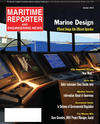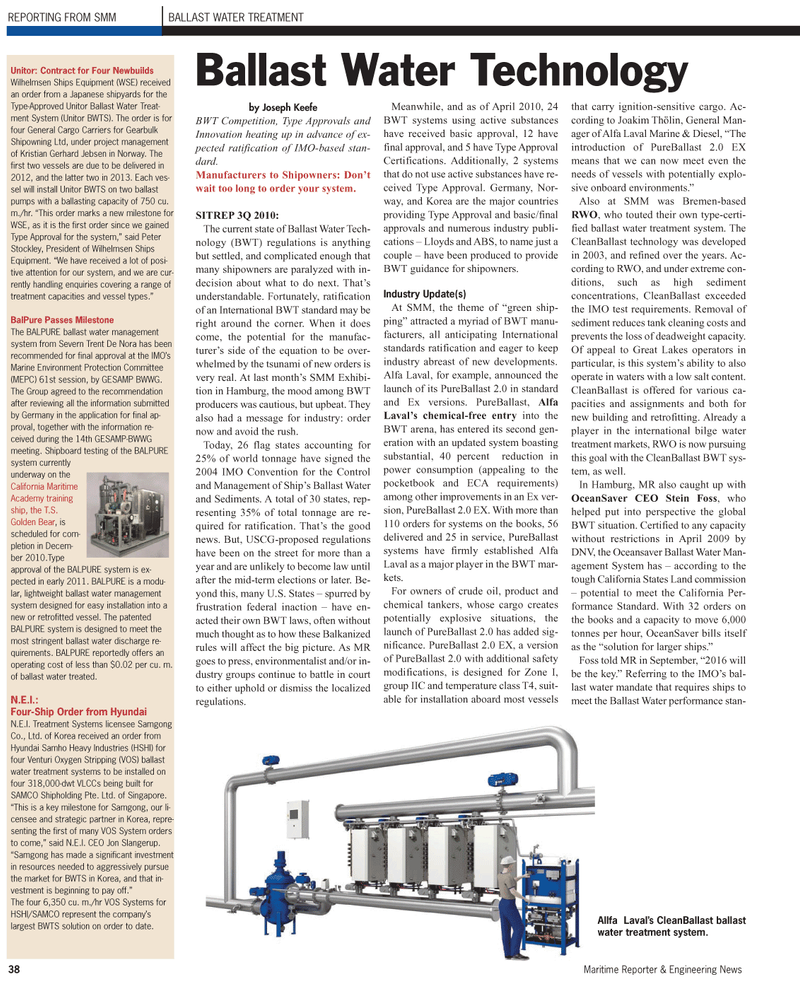
Page 38: of Maritime Reporter Magazine (February 2, 2010)
Read this page in Pdf, Flash or Html5 edition of February 2, 2010 Maritime Reporter Magazine
REPORTING FROM SMM BALLAST WATER TREATMENT by Joseph Keefe
BWT Competition, Type Approvals and
Innovation heating up in advance of ex- pected ratification of IMO-based stan- dard.
Manufacturers to Shipowners: Don’t wait too long to order your system.
SITREP 3Q 2010:
The current state of Ballast Water Tech- nology (BWT) regulations is anything but settled, and complicated enough that many shipowners are paralyzed with in- decision about what to do next. That’s understandable. Fortunately, ratification of an International BWT standard may be right around the corner. When it does come, the potential for the manufac- turer’s side of the equation to be over- whelmed by the tsunami of new orders is very real. At last month’s SMM Exhibi- tion in Hamburg, the mood among BWT producers was cautious, but upbeat. They also had a message for industry: order now and avoid the rush.
Today, 26 flag states accounting for 25% of world tonnage have signed the 2004 IMO Convention for the Control and Management of Ship’s Ballast Water and Sediments. A total of 30 states, rep- resenting 35% of total tonnage are re- quired for ratification. That’s the good news. But, USCG-proposed regulations have been on the street for more than a year and are unlikely to become law until after the mid-term elections or later. Be- yond this, many U.S. States – spurred by frustration federal inaction – have en- acted their own BWT laws, often without much thought as to how these Balkanized rules will affect the big picture. As MR goes to press, environmentalist and/or in- dustry groups continue to battle in court to either uphold or dismiss the localized regulations.
Meanwhile, and as of April 2010, 24
BWT systems using active substances have received basic approval, 12 have final approval, and 5 have Type Approval
Certifications. Additionally, 2 systems that do not use active substances have re- ceived Type Approval. Germany, Nor- way, and Korea are the major countries providing Type Approval and basic/final approvals and numerous industry publi- cations – Lloyds and ABS, to name just a couple – have been produced to provide
BWT guidance for shipowners.
Industry Update(s)
At SMM, the theme of “green ship- ping” attracted a myriad of BWT manu- facturers, all anticipating International standards ratification and eager to keep industry abreast of new developments.
Alfa Laval, for example, announced the launch of its PureBallast 2.0 in standard and Ex versions. PureBallast, Alfa
Laval’s chemical-free entry into the
BWT arena, has entered its second gen- eration with an updated system boasting substantial, 40 percent reduction in power consumption (appealing to the pocketbook and ECA requirements) among other improvements in an Ex ver- sion, PureBallast 2.0 EX. With more than 110 orders for systems on the books, 56 delivered and 25 in service, PureBallast systems have firmly established Alfa
Laval as a major player in the BWT mar- kets.
For owners of crude oil, product and chemical tankers, whose cargo creates potentially explosive situations, the launch of PureBallast 2.0 has added sig- nificance. PureBallast 2.0 EX, a version of PureBallast 2.0 with additional safety modifications, is designed for Zone I, group IIC and temperature class T4, suit- able for installation aboard most vessels that carry ignition-sensitive cargo. Ac- cording to Joakim Thölin, General Man- ager of Alfa Laval Marine & Diesel, “The introduction of PureBallast 2.0 EX means that we can now meet even the needs of vessels with potentially explo- sive onboard environments.”
Also at SMM was Bremen-based
RWO, who touted their own type-certi- fied ballast water treatment system. The
CleanBallast technology was developed in 2003, and refined over the years. Ac- cording to RWO, and under extreme con- ditions, such as high sediment concentrations, CleanBallast exceeded the IMO test requirements. Removal of sediment reduces tank cleaning costs and prevents the loss of deadweight capacity.
Of appeal to Great Lakes operators in particular, is this system’s ability to also operate in waters with a low salt content.
CleanBallast is offered for various ca- pacities and assignments and both for new building and retrofitting. Already a player in the international bilge water treatment markets, RWO is now pursuing this goal with the CleanBallast BWT sys- tem, as well.
In Hamburg, MR also caught up with
OceanSaver CEO Stein Foss, who helped put into perspective the global
BWT situation. Certified to any capacity without restrictions in April 2009 by
DNV, the Oceansaver Ballast Water Man- agement System has – according to the tough California States Land commission – potential to meet the California Per- formance Standard. With 32 orders on the books and a capacity to move 6,000 tonnes per hour, OceanSaver bills itself as the “solution for larger ships.”
Foss told MR in September, “2016 will be the key.” Referring to the IMO’s bal- last water mandate that requires ships to meet the Ballast Water performance stan-
Ballast Water Technology
Allfa Laval’s CleanBallast ballast water treatment system.
Unitor: Contract for Four Newbuilds
Wilhelmsen Ships Equipment (WSE) received an order from a Japanese shipyards for the
Type-Approved Unitor Ballast Water Treat- ment System (Unitor BWTS). The order is for four General Cargo Carriers for Gearbulk
Shipowning Ltd, under project management of Kristian Gerhard Jebsen in Norway. The first two vessels are due to be delivered in 2012, and the latter two in 2013. Each ves- sel will install Unitor BWTS on two ballast pumps with a ballasting capacity of 750 cu. m./hr. “This order marks a new milestone for
WSE, as it is the first order since we gained
Type Approval for the system,” said Peter
Stockley, President of Wilhelmsen Ships
Equipment. “We have received a lot of posi- tive attention for our system, and we are cur- rently handling enquiries covering a range of treatment capacities and vessel types.”
BalPure Passes Milestone
The BALPURE ballast water management system from Severn Trent De Nora has been recommended for final approval at the IMO’s
Marine Environment Protection Committee (MEPC) 61st session, by GESAMP BWWG.
The Group agreed to the recommendation after reviewing all the information submitted by Germany in the application for final ap- proval, together with the information re- ceived during the 14th GESAMP-BWWG meeting. Shipboard testing of the BALPURE system currently underway on the
California Maritime
Academy training ship, the T.S.
Golden Bear, is scheduled for com- pletion in Decem- ber 2010.Type approval of the BALPURE system is ex- pected in early 2011. BALPURE is a modu- lar, lightweight ballast water management system designed for easy installation into a new or retrofitted vessel. The patented
BALPURE system is designed to meet the most stringent ballast water discharge re- quirements. BALPURE reportedly offers an operating cost of less than $0.02 per cu. m. of ballast water treated.
N.E.I.:
Four-Ship Order from Hyundai
N.E.I. Treatment Systems licensee Samgong
Co., Ltd. of Korea received an order from
Hyundai Samho Heavy Industries (HSHI) for four Venturi Oxygen Stripping (VOS) ballast water treatment systems to be installed on four 318,000-dwt VLCCs being built for
SAMCO Shipholding Pte. Ltd. of Singapore. “This is a key milestone for Samgong, our li- censee and strategic partner in Korea, repre- senting the first of many VOS System orders to come,” said N.E.I. CEO Jon Slangerup. “Samgong has made a significant investment in resources needed to aggressively pursue the market for BWTS in Korea, and that in- vestment is beginning to pay off.”
The four 6,350 cu. m./hr VOS Systems for
HSHI/SAMCO represent the company’s largest BWTS solution on order to date. 38 Maritime Reporter & Engineering News

 37
37

 39
39
